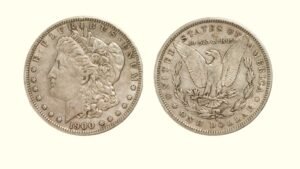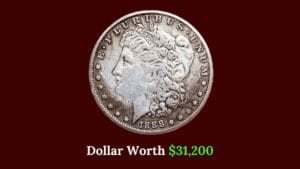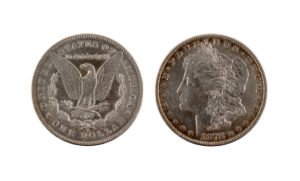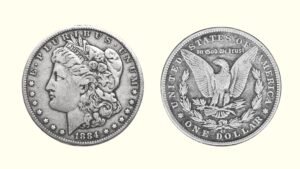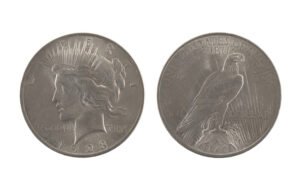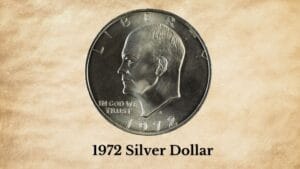As a part of the special Bicentennial Coins series, the 1976 Silver Dollar coin is quite popular among coin collectors. While a regular 1976 Eisenhower dollar might not be worth a lot, the silver dollar can fetch exceptional prices, like an example that a collector bought for over $11,000!
So what makes a 1976 Bicentennial Dollar so valuable? Is it just the silver content, or are there other hidden features? From unique mint errors to valuable proof coins, this detailed price guide explains which rare features can make a 1976 Silver Dollar worth a big fortune of thousands of dollars!
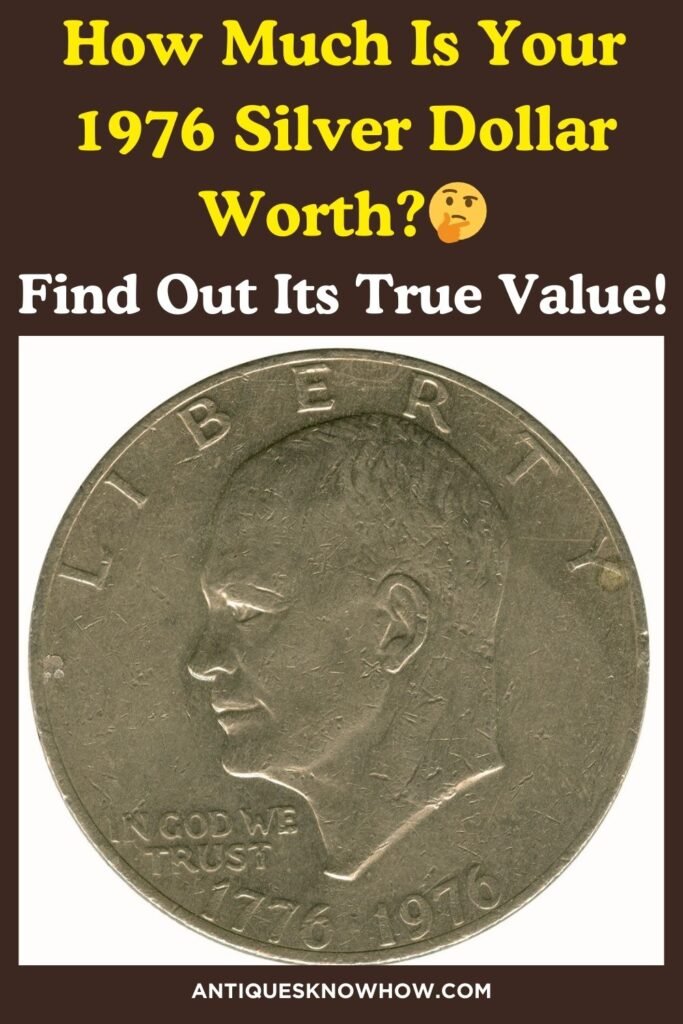
1776-1976 Bicentennial Eisenhower Dollar History
The 1976 Bicentennial Dollar is part of the Eisenhower Dollar or Ike dollar series introduced in 1971. It was specially minted to commemorate the 200th anniversary of the signing of the Declaration of Independence and features the unique reverse design of the Liberty Bell and the moon and the “1776-1976” date.
The 1776-1976 Eisenhower Silver Dollar (as uncirculated and proof coins), as well as the copper nickel clad version, was minted in large quantities. This year marked a significant effort by the U.S. Mint to engage the public in the Bicentennial celebrations, making the 1976 dollar collectible.
| 1976 Bicentennial Dollar | Key Facts |
| Coin Composition | 75% Copper, 25% Nickel over a pure Copper center; 40% Silver, 60% Copper (proof & Uncirculated) |
| Minting Location | Philadelphia, Denver, San Francisco |
| Year of Minting | 1976 |
| Weight | 22.68 grams (copper nickel clad); 24.624 grams (silver clad) |
| Diameter | 38.1 mm |
| Thickness | 2.5 mm |
| Designer | Frank Gasparro, Dennis R. Williams |
| Face Value | $1 (One Dollar) |
| Mint Marks | No Mint Mark – Philadelphia Mint, D – Denver Mint S – San Francisco Mint |
| Total Mintage | 8,906,940 (Total – Over 133 million) |
Understanding 1976 Bicentennial Dollar Design & Composition
Since the 1976 Bicentennial dollar features a reverse design and date different from regular Eisenhower dollars, you must understand its design and physical features in order to spot this valuable coin.
1976 Bicentennial Dollar Obverse:

- A left-facing profile portrait of President Dwight D Eisenhower
- “LIBERTY” written at the top
- The words “IN GOD WE TRUST” appear at the lower left side
- The mint year “1776-1976” displayed on the bottom
- The designer’s initials, “FG” for Frank Gasparro, on the lower left of Eisenhower’s neck
- The mint mark, if present, below the neck truncation line
1976 Bicentennial Dollar Reverse:

- The Liberty Bell, with the moon in the background, at the center
- The words “UNITED STATES OF AMERICA” appear alongside at the upper edge
- The denomination “ONE DOLLAR” written below the central design
- Two stars along the edge
- The words “E. Pluribus Unum” below the moon
- The reverse designer’s initials, “DRW” for Dennis R. Williams, in small font right below the bell
Note: There are two types of 1976 Eisenhower Dollar: Type I has the original wider and less sharp lettering on the reverse, and Type II has narrower, sharper lettering.
Coin Composition, Size & Dimensions
The 1976 Eisenhower Silver Dollar comprises 40% silver and 60% copper, weighing 24.6 g, while the regular copper nickel clad versions contain 75% copper and 25% nickel, weighing 22.68 g.
The diameter and thickness of both versions are the same: 38.1 mm (1.5 inches) and 2.58 mm (0.1 inches), respectively. Besides, both 1976 Bicentennial Eisenhower dollar versions have a uniform reeded edge, a defining characteristic of many U.S. coins!
Finding the 1976 Silver Dollar Value (3 Key Factors)
Generally, a 1976 Bicentennial Silver Dollar coin is worth around $10 to $15 in circulated condition. However, silver dollars in flawless condition or with rare characteristics can fetch up to $20,000 or more!
Here are the key factors that determine a 1976 silver dollar coin value:
1. Coin Grading and Condition
Your 1976 silver dollar’s condition is one of the most important factors in assessing its worth. While you can manually evaluate the condition based on the coin’s luster, clarity, and wear, grading services grade the coins on a scale from P-1 to MS-70, with higher grades meaning better condition.
The 1976 Silver Dollar in Mint State (MS) or Proof (PR) condition will be worth more than a coin in lower grades like Good (G) or Fine (F).
2. Mint Marks & Mintage
The mintage of a coin decides how easily it is found or how rare it is. As for the 1976 Eisenhower Silver Dollar (Type II), the total mintage is over 8.9 million, including proofs and uncirculated coins.
All 1976 silver dollars were struck at the San Francisco Mint, bearing the “S” mint mark on the obverse, except for one proof silver coin mistakenly struck at the Philadelphia Mint, which is the rarest and can be highly valuable. PCGS estimates its price to be a whopping $850,000 in PR-66 grade.
1976-S Silver Dollar Uncirculated Coins
The United States Mint produced around 4,908,319 uncirculated 1976 silver dollars with 40% silver composition. Circulated 1976 $1 Silver coins are generally worth $5 – $15, while uncirculated coins can fetch $20 to $100, with higher grades reaching up to $20,000 or more!
| Coin Grades | Condition Details | 1976 S Silver Dollar Value |
| Poor (0) to Extremely Fine (XF45) | Significant wear, faded but visible details | 50 cents to $2 |
| Almost Uncirculated (AU50) to Mint State (MS60) | Slight wear on highest points, visible marks or blemishes | $2 – $10 |
| Mint State (MS61 – MS64) | Uncirculated with minimal wear | $10 – $20 |
| Mint State (MS65 – MS66+) | Nearly flawless with very minor imperfections | $15 – $40 |
| Mint State (MS67 – MS67+) | Well-preserved with no major flaws | $35 – $130 |
| Mint State (MS68 or MS68+) | Nearly perfect, luster, no major marks or flaws | $200 – $4,500 |
| Mint State (MS69 -MS70) | A perfect, flawless coin | $10,000 – $20,000+ |
1976-S Silver Dollar Proof Coins
A total of 3,998,621 silver dollar proof coins (40% silver content) were struck in San Francisco. The average value of these proof coins ranges from $10 to $60, depending on the condition. The highest price a 1976 Bicentennial Silver Dollar Proof coin ever sold for is $1,077 in PR-70 grade on eBay!

The proof coins are further classified into three designations: PR (regular proofs), Cameo (CAM) proofs, and Deep Cameo (DCAM) proofs. 1976 $1 DCAM proof coins with the strongest contrast between devices and mirror-like fields (in high grade) are the most valuable, while the regular proof and CAM varieties generally sell for $10 – $70.
As for the clad 1976 Eisenhower Dollar version, it was minted in both Type I and Type II versions at three locations. Type II versions are slightly more valuable than Type I.
- 1976 No Mint Mark Dollar: Around 117,337,000 clad dollars were at the Philadelphia Mint, identified with no mint mark. In average condition, these coins are worth around $2, but uncirculated examples can reach up to $10 – $40, with higher grades fetching up to $10,000 or more.
- 1976 D Eisenhower Dollar: The Denver Mint produced 103,228,274 clad dollar coins (Type I & Type II) featuring the “D” mint mark. These coins generally sell for $10 – $50 in uncirculated condition, with higher grades fetching up to $14,000, like this MS-67 Type I example that sold for $11,162 on Heritage Auctions!
- 1976-S Eisenhower Dollar: The San Francisco Mint also produced 6,995,180 clad proofs of the 1976 dollar with the “S” mint mark. Based on the condition and proof variety (CAM & DCAM), values can range from $10 to $250, with PR70 DCAM examples fetching $2,500 to $7,500 or more. The highest released price of a DCAM proof is $25,300!
3. 1976 Silver Dollar Errors List
Special flaws that occur during the minting process, aka mint errors, can also boost your 1967 Bicentennial Silver dollar’s worth. Here are some notable errors to look for:
Flip Over Double Strike
When a 1976 Eisenhower Dollar is double struck in the die after getting flipped over, the coin’s obverse design gets partially impressed on the reverse, slightly rotated. A Type II AU-58 example of this error coin was sold at Heritage Auctions for a stunning price of $2,530!
Clipped Planchet
This error happens when a piece of the 1976 dollar planchet gets cut off due to a malfunction, resulting in a partial coin with an incomplete design. The clip can occur in one or more places. For example, this 22% Double Clipped Planchet MS-62 1976 $1 Type Two coin that sold for over $250 on Heritage Auctions!
Struck Through Embedded Tape
This rare 1976 silver dollar coin was produced when a piece of the tape got in the die as the coin was being struck, getting impressed into its design. One of the very few discovered, an MS-65 example of this error coin, reportedly sold for about $1,500 in a coin auction!
How to Know If a 1976 Eisenhower Dollar Is Silver?
To identify if your 1976 Eisenhower Dollar is made of silver or not and if your 1976 silver dollar is genuine, you need to examine its certain features, as explained in the following steps:
- Mint Mark: The first identifier of a 1976 silver dollar is the “S” mint mark, as 40% silver versions were only struck at the San Francisco Mint. If your coin has the mint mark, ensure it matches the authentic style, size, and font!
- Composition: The 1976 dollar coin should have an unmistaken 40% total silver content. You can use a magnet to check for ferrous metals.
- Weight: Remember, a 1976 Bicentennial Silver dollar weighs 24.6 grams, while the clad version weighs 22.68 grams. If your silver coin is lighter or heavier, it could be a fake.
- Edge: Although both clad and silver 1976 dollars have reeded edges, the silver coin will have a whiter and shinier edge with a different feel (to touch) due to its weight and composition.
Note: This article is intended for informational, educational, and entertainment purposes only. Some images are illustrative and may not represent actual brands, products, or related entities. All trademarks, product names, brand logos, packaging, and other intellectual property referenced remain the exclusive property of their respective owners. Any brand mentions or references are provided solely for descriptive and educational context and do not imply any formal or commercial association.


